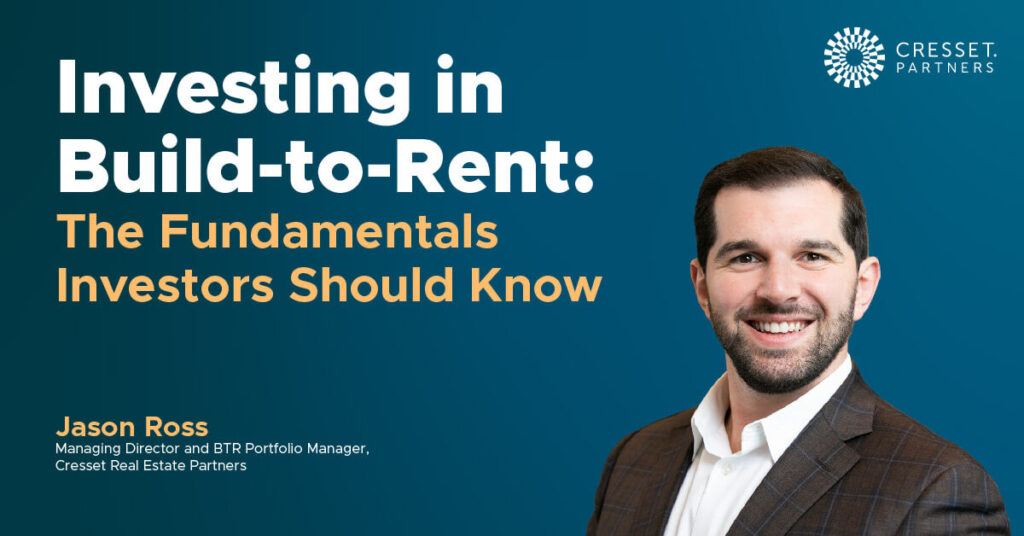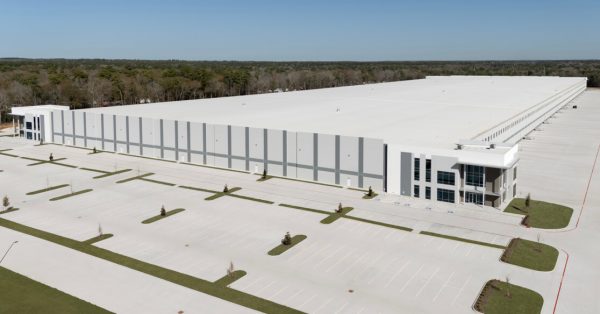
By Jason Ross, Managing Director and BTR Portfolio Manager, Cresset Real Estate Partners
Millennials are rethinking the American dream of owning their own homes. Baby boomers are downsizing but still desire the comforts of living in a single-family residence without the upkeep and maintenance. A chronic lack of housing that shows no signs of abating (a national shortage of more than 3.1 million housing units1).
These are a few of the several demographic and ideological shifts that have converged to create a rapidly emerging housing market investment strategy known as build-to-rent (BTR). For real estate investors, BTR presents an opportunity to gain strategic early entry into this growing housing sector with potential portfolio diversification, economic and tax advantaged incentives.
Defining Build to Rent
BTR developments are new residential communities that offer individuals and families single-family housing for rent rather than for sale. BTR communities have the characteristics of single-family homes but are built for renters desiring features not typically offered with traditional housing. Unlike traditional residential single-family home developments, where homes are sold individually to private buyers, BTR communities are owned by institutional investors who retain ownership of all the homes and lease and manage the properties.
BTR properties are defined as communities consisting of 50 or more homes or townhomes. While they operate similarly to multifamily real estate, there are several defining characteristics of a BTR community:
- Institutional Property Management: High-quality, for-rent housing owned by a single entity and professionally managed by operators who handle leasing, landscaping, repairs and maintenance for the community.
- Product Features: A diverse housing mix, including cottages, townhomes, and single-family detached homes, providing options for millennials, families, and empty nesters. For residents, privacy is a key differentiator for BTR homes, which are designed with private entries, yards, and garages, enhancing privacy and convenience. Homes are equipped with modern design elements that cater to today’s renters.
- Larger Unit Sizes: Traditional multi-family developments are focused on the single renter or young families, so they offer few three- and four-bedroom homes. BTR developments typically offer more than 60% of homes as three- or four-bedroom single-family dwellings.
- Traditional Home Locations: BTR communities are strategically located with proximity to employment and retail nodes, and within desirable school districts, depending on the market.
- Neighborhood Feel: BTR communities feature low-density homes with yards and additional greenspaces, such as dog parks and playgrounds.
- Community Amenities: In addition to various kinds of green spaces, BTR communities often feature amenities that one might find in upscale apartment buildings, such as swimming pools, fitness centers, and a clubhouse.
Because of these attractive features, and because they are built with rental in mind from the outset, BTR communities enhance tenant satisfaction and retention, appealing to investors seeking a diversified tenant base with mitigated risk.
The Driving Factors Behind BTR Demand
There are multiple driving factors in the BTR space, such as the chronic housing shortage in the U.S., lower monthly costs compared to home ownership, decreased urbanization, and workplace dynamics (hybrid work and work-from-home). In addition to these influences, changing demographics and evolving lifestyle preferences post-COVID have also played a key role. A closer look at these core driving factors accelerating BTR’s momentum reveals the following details:
Housing Shortage
- Existing home inventory levels in the U.S. have normalized at ~50% below the long-term average.2
- There is an existing housing shortage of more than 3 million homes in the U.S.3
- Single-family permit estimates are projected to remain below the long-term average.
Current homeowners with mortgages well below today’s interest rates are often unwilling to sell, thereby exacerbating the housing shortage.
Housing Affordability
- Renting remains as much as 50% cheaper than owning a home considering current home prices, financing levels and additional home ownership costs, for instance, insurance and taxes.4
- Home price appreciation is outpacing wage growth, and student loans are at all-time highs, contributing to the inability of many to afford a down payment on a home.5
- Constructions costs continue to rise, reducing the likelihood that additional homes will be built to satisfy the pent-up demand.
- For housing affordability to return to 2016-2019 levels, it would take one of three things, or a combination of them to occur6:
- The median home price of a single-family home would have to fall 38% to $257,000 from $414,340.
- Median household income would have to rise more than 60%, to $134,000.
- The current mortgage interest rate would have to fall from 6.5% to 2.35%.
Tailored Product Model
- Tenants value the extra space, higher ceilings, private backyards and garages, and proximity to employment and quality public schools.
- Empty nesters looking to downsize are drawn to maintenance-free lifestyles.
- The shift to a hybrid or work-from-home environment requires more housing space.3
Demographic Shift
- BTR is expected to benefit from evolving preferences of both the baby boomer and millennial generations, two of the largest generations in the country.3
- Millennials have a higher percentage of renters by choice and are transient in nature when compared to other demographics.3
- The 35–44-year-old population is projected to increase by more than double the
the U.S. average over the next five years.6
What Investors Should Know
For investors, these driving factors translate into a strategic and compelling investment thesis with potential strong upside created by capturing value enhancement through early development addressing burgeoning tenant demand.
The United States has approximately 15 million single-family rental (SFR) homes, making up 34% of all rental units and 12% of total occupied housing. Of those 15 million SFR homes, 3.5 million became rental properties only since 2005. Comparatively, BTR homes currently represent just 1.5% of the SFR market (around 340,000 units).6 Unlike scattered SFRs, BTR are purpose-built rental communities with shared amenities and professional management, designed specifically for renters. BTR addresses the housing market’s “missing middle,” which is the gap between traditional scattered site SFR homes and mid-rise and high-rise apartments.
The BTR sector is marked by its focus on scale and efficiency. Larger-scale developments allow developers to optimize construction and operational costs. Additionally, BTR projects are designed to appeal to a broad demographic, including families, young professionals, and retirees, thereby diversifying the tenant base and mitigating risk.
BTR housing represents an innovative and increasingly popular approach to real estate investing. By focusing on creating rental properties that cater to shifting demographics and evolving tenant needs, and incorporating efficient management practices, BTR offers investors a potential range of benefits, including portfolio diversification, tax benefits, and the opportunity to create further diversification of investments and income streams.
As the rental market continues to grow and evolve, BTR is poised to become a key player in the real estate investment landscape.
Contact us to learn more about investing in BTR.
1CBRE Research, CBRE Econometric Advisors, Census Bureau January 2023
2Redfin.com (Accessed April 2024)
3Berkadia (September 2023) Single-Family Rental & Build-to-Rent Market Overview
4Green Street, U.S. 2024 SFR Outlook
5Wall Street Journal https://www.wsj.com/economy/housing/theres-never-been-a-worse-time-to-buy-instead-of-rent-bd3e80d9
6Bloomberg, High Prices, Low Supply: Three Swing State Cities Show the Housing Crunch
Disclosures:
The information contained in these materials is not intended to provide professional, investment, legal, or tax advice and should not be relied upon in that regard. The contents of these materials are for general information only and are not provided with regard to your specific investment objectives, financial situation, tax exposure, or particular needs. The contents hereof are not a recommendation of, or solicitation for, the subscription, purchase, or sale of any security, including the fund(s) and/or investment products mentioned herein.
Investments, including interests in real estate are subject to investment, tax, regulatory, market, macroeconomic, liquidity, and other risks, including loss of the principal amount invested. Developing real estate properties can add another layer of risks dependent upon ongoing project costs and timing objectives.
Cresset refers to Cresset Capital Management, CP Parent, LLC, and all of their respective subsidiaries and affiliates. Cresset Asset Management, LLC, also conducting advisory business under the names of Cresset Sports & Entertainment and CH Investment Partners, provides investment advisory, family office, and other services to individuals, families, and institutional clients. Cresset Partners, LLC, provides investment advisory services strictly to investment vehicles investing in private equity, real estate, and other investment opportunities. Cresset Asset Management, LLC, and Cresset Partners, LLC, are SEC registered investment advisors.



